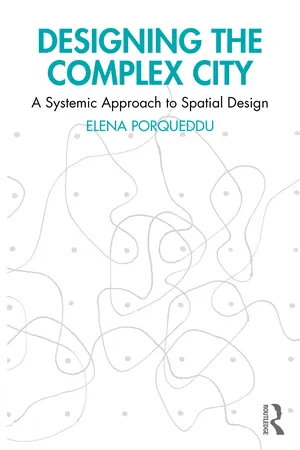
- English
- ePUB (mobile friendly)
- Available on iOS & Android
About this book
How can designers address the emergent self-organizing nature of complex urban environments? Designing the Complex City highlights how both an excess and a lack of design control might contrast the lively complexity of cities, their adaptive and evolutionary capacity. By using key concepts from systems thinking, complexity sciences, life sciences, cognitive sciences, and social sciences, the book frames a systemic spatial design approach aimed at enhancing the potential of different spatial design disciplines to navigate place-specific emergent transformations without overdetermining their formal outcome. A range of heterogeneous case studies, developing at different scales, show how embracing a design approach that is embodied, open-ended, contextually responsive, incremental and adaptive does not question the relevance of designers' specific skills in shaping the physical structure of cities; it may rather increase their potential to effectively intervene in complex adaptive cycles of urban decay and self-regeneration.
Designing the Complex City provides insights for students, researchers, and academics in architecture, interior design, urban and landscape design, planning theory, and urban studies. It is essential reading for all designers who seek to proactively and meaningfully intervene in spontaneous socio-spatial dynamics.
Frequently asked questions
- Essential is ideal for learners and professionals who enjoy exploring a wide range of subjects. Access the Essential Library with 800,000+ trusted titles and best-sellers across business, personal growth, and the humanities. Includes unlimited reading time and Standard Read Aloud voice.
- Complete: Perfect for advanced learners and researchers needing full, unrestricted access. Unlock 1.4M+ books across hundreds of subjects, including academic and specialized titles. The Complete Plan also includes advanced features like Premium Read Aloud and Research Assistant.
Please note we cannot support devices running on iOS 13 and Android 7 or earlier. Learn more about using the app.
Information
Table of contents
- Cover
- Half Title
- Endorsements
- Title Page
- Copyright Page
- Table of Contents
- List of figures
- List of tables
- 1. Introduction: Urban complexity, systems thinking, spatial design
- 2. An embodied approach: Intervening in spontaneous socio-spatial dynamics
- 3. Open design: Directing rather than mastering emergent transformations
- 4. Design as a ‘good perturbation’: Navigating adaptive cycles in cities
- 5. A multi-scale living atlas: Detecting leverage points for spatial action
- 6. Systemic spatial design: Enhancing synergies between different design disciplines
- 7. An eco-systemic approach: Fostering city vitality
- 8. Conclusion: Cultivating urban complexity: The systemic turn in spatial design disciplines
- Index